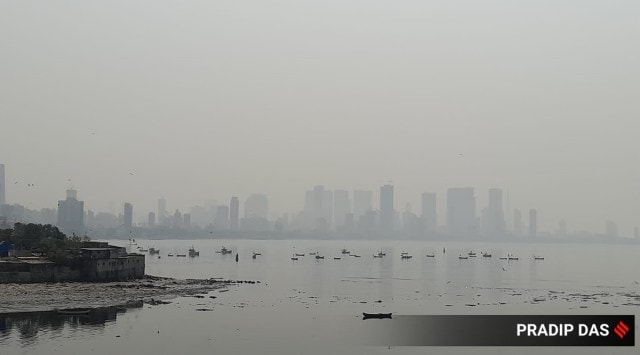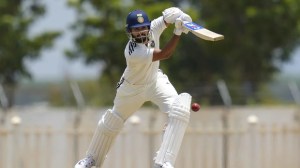Mumbai’s air quality deteriorates, worse than Delhi’s again
Experts have cited the current weather condition as well as external factors like construction and vehicular emission for the deteriorating air quality.
 A smoggy sky was observed in Mumbai's Bandra on Thursday morning. (Express Photo by Pradip Das)
A smoggy sky was observed in Mumbai's Bandra on Thursday morning. (Express Photo by Pradip Das) Mumbai recorded poor air quality than Delhi yet again on Thursday. According to System of Air Quality and Weather Forecast and Research (SAFAR), the maximum city’s overall air quality index (AQI) stood at 283 (poor) in comparison to Delhi’s 156 (moderate).
Pollution levels have been soaring in the financial capital for the last few weeks, making it difficult for residents, especially the elderly and those with breathing trouble, to go out. Experts have cited the current weather condition as well as external factors like construction and vehicular emission for the deteriorating air quality.
Meanwhile, several pockets of Mumbai continued to record poor to very poor AQI on Thursday. Bandra-Kurla Complex (BKC) recorded the worse AQI of 320, followed by 318 in Andheri, 305 in Malad and 301 in Chembur. Bhandup recorded an AQI on 283, followed by 211 in Worli 193 in Borivali, 169 in Colaba and 149 in Mazagaon. Navi Mumbai meanwhile recorded an AQI of 329.
According to SAFAR dashboard, Mumbai’s AQI is likely to remain in the poor category even after three days, with PM2.5 levels of 119 µgm/m3 and PM10 levels of 205 µgm/m3.
This winter, Mumbai has recorded the highest number of days with ‘poor’ to ‘very poor’ AQI between November 2022 and January 2023, nearly double the number of days in the same period in 2021-2022, and 2020-2021, and thrice the days during the same period in 2019-2020.
The city is not experiencing cooler temperature for the past one week and on Thursday, Mumbai recorded a maximum temperature of 36 degrees, while the minimum temperature was 19.4 degrees.
Bhagwan Kesbhat, founder of NGO Waatavaran said that Mumbai is experiencing multi-dimensional emission, which is causing poorer AQI even though the winter has ended in the city.
“The number of vehicles plying on roads this year is much higher compared to last 2-3 years, when people would hardly get out due to the pandemic. Also, in satellite cities like Thane, Kalyan, Dombivli and Taloja, non-monitored industrial work is taking place which is polluting the air significantly and this is affecting Mumbai as well, similar to how burning of crops in Haryana and Punjab affects Delhi,” Kesbhat said.
“These issues need a solid-holistic policy otherwise, in the days to come the AQI will only get worse in the city,” he added.
Gufran Beig, senior scientist from SAFAR said, “Throughout the last winter, Mumbai has experienced slow to very slow windspeed in most of the days, due to which the suspended particulate matters remained suspended in air for longer duration, therefore affecting the AQI, alongside other factors like debris dumping and construction works.”
Data from SAFAR shows that of the 92 days between November 1, 2022 and January 31, 2023, Mumbai has recorded ‘poor’ and ‘very poor’ AQI on 66 days. The data also states that of the total 92 days, Mumbai has recorded ‘good’ and ‘satisfactory’ AQI on only one day.
According to SAFAR’s AQI monitoring chart, an AQI between 0-50 is termed ‘good’, between 51-100 it is ‘satisfactory’, 101-200 is ‘moderate’, 201-300 ‘poor’, 301-400 is ‘very poor’ and beyond 400, AQI is labelled ‘severe’.
Municipal Commissioner Iqbal Chahal, during his recent budget speech, had acknowledged that construction work is resulting in dust pollution.
With Mumbai continuously looming under poor air quality for more than three months now, the Brihanmumbai Municipal Corporation (BMC) as part of its Rs 52,619 crore budget for the financial year 2023-24 has announced a seven-step policy for mitigating air-pollution in the megapolis.
The BMC proposed to set up air-purifier towers, along the lines of smog towers of Delhi, Lucknow and Chandigarh, for mitigating the issue. However, city-based activists have criticised this decision, stating that it will not lead to any long-term results.







